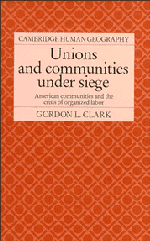Book contents
- Frontmatter
- Contents
- List of tables
- Preface
- Acknowledgments
- PART I ECONOMY AND COMMUNITY
- 1 Crisis of organized labor
- 2 Understanding union growth and decline
- PART II DRAMA OF ECONOMIC RESTRUCTURING
- PART III UNION PERFORMANCE IN REPRESENTATION ELECTIONS
- PART IV REGULATING LOCAL LABOR–MANAGEMENT RELATIONS
- PART V PROSPECTS FOR ORGANIZED LABOR
- Appendix 1 Variables and data sources
- Appendix 2 Cases cited
- Notes
- Bibliography
- Name index
- Subject index
2 - Understanding union growth and decline
Published online by Cambridge University Press: 13 October 2009
- Frontmatter
- Contents
- List of tables
- Preface
- Acknowledgments
- PART I ECONOMY AND COMMUNITY
- 1 Crisis of organized labor
- 2 Understanding union growth and decline
- PART II DRAMA OF ECONOMIC RESTRUCTURING
- PART III UNION PERFORMANCE IN REPRESENTATION ELECTIONS
- PART IV REGULATING LOCAL LABOR–MANAGEMENT RELATIONS
- PART V PROSPECTS FOR ORGANIZED LABOR
- Appendix 1 Variables and data sources
- Appendix 2 Cases cited
- Notes
- Bibliography
- Name index
- Subject index
Summary
How might patterns noted in the previous chapter be explained? What theoretical perspectives are available for interpreting the decline of American unions? There is a massive literature on American unions, and the unionization process. The focus of this chapter is reserved for economic-oriented and geographical models of American unions. Two related issues are addressed: one concerns how we ought to understand the growth and decline of unions over time and place. The other concerns how we ought to conceptualize unions as organizations. In conclusion, comments are made about the methodological bases of analyses presented in subsequent parts of the book.
The literature on unions extends over a long period of time and has seen many different frameworks come and go. Not surprisingly, there have been numerous attempts to review and systematize this literature, providing a steady stream of innovative modes of understanding the unionization process. Yet, for all this research, there is a great deal of pessimism about the utility of recent research. Fiorito and Greer (1982:19) observed that “[a]t present, there is no satisfactory model of union growth [or decline].” This sentiment is echoed by Hirsch and Addison (1986:72), who commented about a popular technique of analysis that “time series studies available to date tell us very little [about the current crisis of American unions].”
It appears that many researchers are uncomfortable with the hetero-geneity of union experience, and would prefer an integrative framework which would eschew diversity for a standard model applicable to an average situation.
- Type
- Chapter
- Information
- Unions and Communities under SiegeAmerican Communities and the Crisis of Organized Labor, pp. 22 - 42Publisher: Cambridge University PressPrint publication year: 1989

